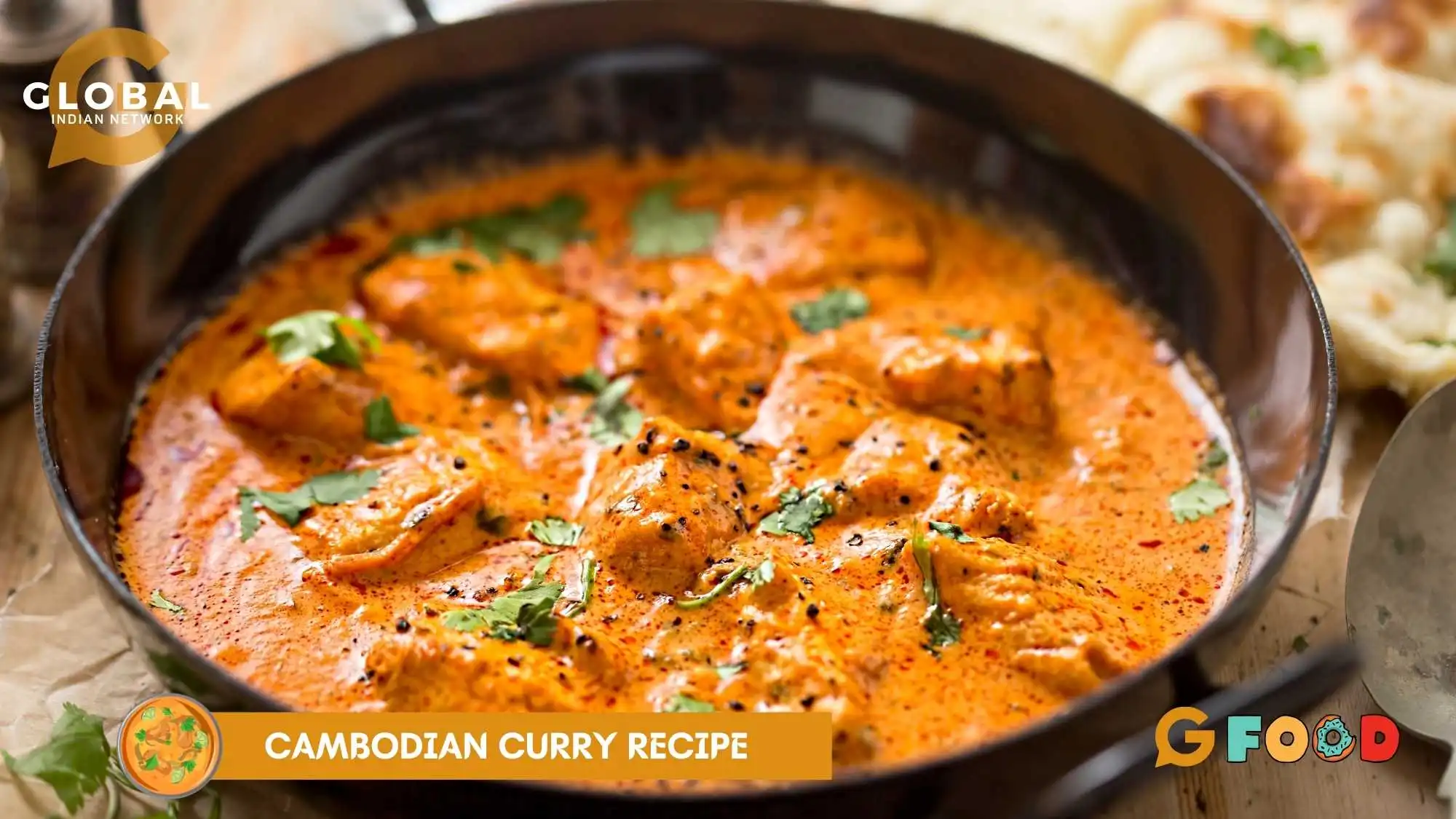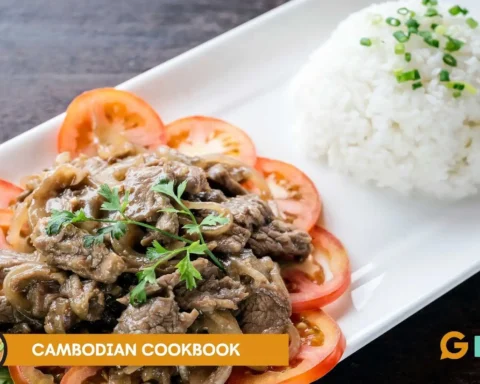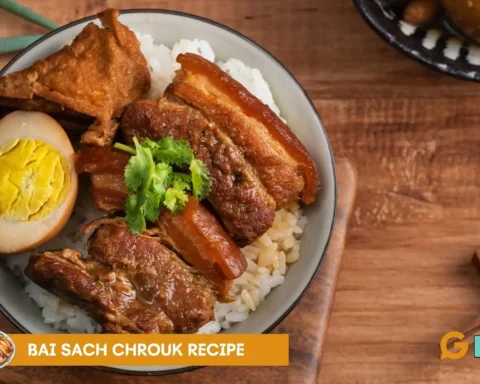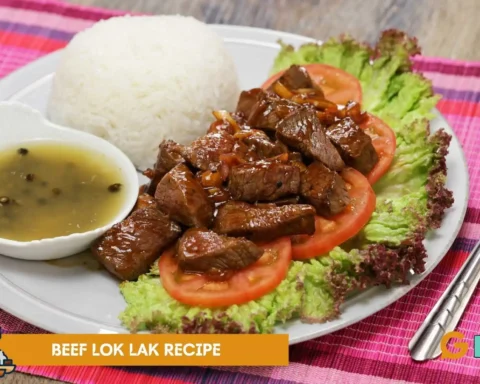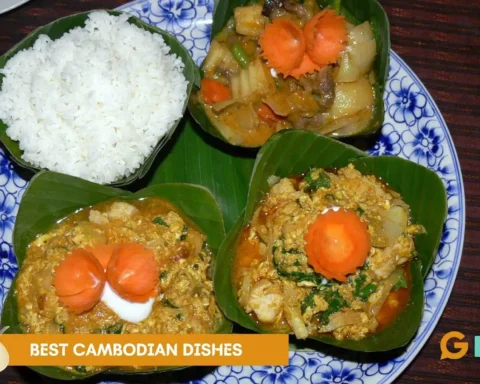When it comes to curry, many picture creamy, coconut milk-rich dishes bursting with a fiery spice level, especially those from India and Thailand. But let this blog take you on an exhilarating journey to the southern countryside of Cambodia, where an untold magic unfolds! Curries are a staple in Cambodian cuisine, featuring comforting yet zesty, refreshingly light, and tangy flavors. And the good news is that crafting these flavourful curries in the coziness of your kitchen is not as complicated as rocket science! It’s pretty simple and fun if you get the ingredients and the enthusiasm right!
Check out this space for an authentic Cambodian curry recipe you can prepare for special occasions like fun family dinners or when you want to warm up with a delicious dish on the couch.
Table of Contents
What Makes Cambodian Curry So Special?
This beloved Cambodian dish, also known as Kari or Cari, is a rich, coconut-based dish esteemed within Khmer households and known for its aromatic and bright flavors. Cambodian curries prioritize balance, depth, and aroma rather than just heat and excessive spice levels.
One of the defining features of the Cambodian curry recipe is the use of kroeung, a complex paste made from herbs and spices. This aromatic concoction prominently includes native ingredients like lemongrass, turmeric, kaffir lime, galangal, and garlic. Together, these components create an irresistible symphony of flavors that reflect the rich culinary heritage of Cambodia. If this sounds alien to you, don’t worry, we have got you covered in one of our following sections on how to prepare this paste in the most authentic way possible.
Core Ingredients in a Cambodian Curry Recipe
When preparing ingredients for a Cambodian curry recipe, the key lies in the combination of fresh, high-quality ingredients. Traditional recipes typically feature bone-in chicken thighs or drumsticks for authenticity, though variations may include beef, tofu, or prawns. Essential vegetables such as eggplant, carrots, sweet or white potatoes, and long or green beans provide depth and texture, while bamboo shoots can be added for an extra touch.
The aromatic base is critical, incorporating ingredients like lemongrass, galangal, garlic, shallots, and kaffir lime leaves, along with turmeric and either shrimp paste (kapi) or fermented fish paste (prahok) for that distinctive umami flavor. To create the curry’s luscious sauce, both thick and thin coconut milk mixed with water or chicken broth, and a splash of fish sauce are used. The final touches of palm sugar and salt, with a squeeze of lime juice if desired, help to balance the flavors.
Ultimately, the secret to the success of a Cambodian curry recipe lies in the freshness of its components, including a freshly pounded paste, good-quality coconut milk, and vegetables that retain their shape during cooking! It’s quite a list. However, the ingredients are not too difficult to find. You can order them online or from Asian markets near you. If you are unable to find an ingredient, just use an available substitute, and the curry will still taste incredible, and the difference will hardly be noticed.

Making Authentic Kroeung Paste
To create an authentic Cambodian curry, it all begins with a flavorful kroeung paste, particularly red kroeung, which is traditionally used as a base for Cambodian chicken curry but can act as a base for other dishes too, from soups to stir-fries.
Key Ingredients
- 2 stalks of lemongrass (using only the white parts)
- 3 cloves of garlic
- 2 shallots
- An inch of galangal
- An inch of fresh turmeric (or one teaspoon of ground turmeric)
- 5 dried red chilies that have been soaked and deseeded
- 2 kaffir lime leaves
- Shrimp paste for added depth (optional)
How To Prepare It
To prepare the kroeung, you can either use a mortar and pestle, finely chopping all the ingredients before pounding them together until a smooth and fragrant paste forms, or opt for a blender, adding a small amount of water or coconut milk to help achieve the desired consistency.
Although there is no set way to make this paste, some Cambodian chefs prefer more lemongrass or turmeric and less galangal. This curry paste serves as the foundation for your Cambodian curry recipe, distinguishing it from Thai or Indian varieties with its unique dimension of flavor and fragrant profile.
Master the Cambodian Curry Recipe
Now that you have your kroeung ready, it’s time to bring your Cambodian curry recipe to life with this simple method. This authentic dish is perfect for serving a small family gathering and makes a delightful meal for any occasion.
Key Ingredients (Serves 4-6 People)
- 8-9 chicken pieces
- 3 tbsp of vegetable or cooking oil
- 6 tbsp of red kroeung paste
- 1 large onion, chopped
- 1 large carrot, sliced
- 1 eggplant, cubed
- 2 potatoes, peeled and chopped
- 1 sweet potato, peeled and chopped
- 1 cup green beans or snake beans, trimmed
- 2 cups creamy coconut milk
- 2 cups water or stock
- 2 tbsp fish sauce
- 2 tbsp palm sugar
- Salt to taste
How To Prepare It
Step 1
Sauté the paste: Start by heating the cooking oil in a large pot over medium heat. Add the kroeung paste and stir-fry for about 2-3 minutes until it becomes fragrant, filling your kitchen with wonderful aromas.
Step 2
Add chicken pieces: Next, incorporate the chicken pieces into the pot. Allow them to brown slightly in the vibrant spice paste, ensuring they absorb all the delicious flavors.
Step 3
Simmer the base: Pour coconut milk and water (or stock) into the pot. Bring the mixture to a boil, then lower the heat to let it simmer.
Step 4
Add the crunchy vegetables: Add in the sliced carrots, chopped potatoes, cubed eggplant, and green beans. Let the curry simmer uncovered for approximately 20-25 minutes, stirring occasionally to ensure even cooking.
Step 5
Season to taste: Finish off by adding the fish sauce and palm sugar, and season with salt. Allow the curry to simmer for another 10 minutes until the sauce thickens and the vegetables are tender.
And voila! Your curry is ready to be served. Serve it hot with steamed white rice or fresh bread.
Variations (Vegan and Seafood Options)
Cambodian cuisine is wonderfully adaptable, allowing locals and foreigners to customize the curry recipe to suit various dietary preferences. For a vegan version, substitute chicken pieces with tofu, use soy sauce instead of fish sauce, and increase the amount of mushrooms to enhance the umami flavor. If you’re opting for a seafood twist, add prawns or firm white fish towards the end of cooking, simmering gently for 5 to 10 minutes to avoid overcooking. Yes, everyone can enjoy the Cambodian curry recipe!
Enjoy the Cambodian Curry Recipe, the Traditional Way!
Cambodian cooking methods involve a variety of serving styles, each enhancing its rich flavors. While the most common way to enjoy this aromatic curry is with a steaming bowl of fragrant jasmine rice, which perfectly absorbs the vibrant spices and creamy sauce, creating a hearty dinner option, it can also be relished alongside a crisp French baguette, a nod to the country’s colonial past that adds a crunchy contrast and allows for delicious dipping.
In southern Cambodia and during special festive occasions, the curry is often served over delicate rice vermicelli noodles, which soak up the curry’s essence, offering a light yet fulfilling option. To elevate the dish further, a garnish of fresh cilantro introduces a burst of flavor and herbal brightness, while lime wedges add zesty and tangy flavors, and slices of green chili bring additional spice, combining to create a visually appealing and flavorsome experience at par with popular Cambodian restaurants.
Tips From Cambodian Home Cooks
To cook like a local chef, you ought to be familiar with these secrets about the Cambodian curry recipe straight from their kitchens (and our dedicated research).
- First and foremost, opt for bone-in meat. Choosing cuts with bones enhances the richness of your broth, infusing it with a deep, savory flavor that truly elevates your dish perfect as winter meals.
- Next, prepare kroeung in bulk. This fragrant curry paste, a cornerstone of Cambodian cooking, freezes beautifully. By making it in batches, you can streamline meal preparation for future culinary adventures, saving time while still enjoying those layers of flavor.
- Achieving flavor harmony is also essential. The secret lies in balancing sweetness and saltiness, so combine palm sugar (or brown sugar) with fish sauce to create a symphony of flavors significant to Cambodian food.
- Moreover, resist the urge to rush the cooking process. A gentle, prolonged simmer allows all the ingredients to meld beautifully, extracting layers of depth and complexity in your curry. A bit of time with mild heat can go a long way!
Finally, just before serving, consider finishing your dish with a splash of coconut cream. This addition can transform your curry, adding a luscious, creamy richness that takes the flavor to new heights. By following these tips, you’ll create a Cambodian curry that’s delicious and a true reflection of the vibrant Cambodian food.
It’s your Time to Shine!
Whether you’re cooking for a weeknight family meal or hosting friends for a Southeast Asian-inspired meal night, this Cambodian curry recipe is sure to impress. With its gentle spices, creamy coconut milk base, and crunchy vegetables, it’s a cozy dish that is both nourishing and bright flavors. By learning to make kroeung from scratch and understanding the cultural significance of each ingredient, you can truly master the Cambodian cooking style like a pro. More importantly, you’ll be keeping a beautiful culinary tradition alive in your kitchen.
So gather your ingredients, take your time with the paste, and let the aromas guide you to the Asian dish worthy of any celebration. Once you try this comprehensive guide, it may become a regular favorite at your dinner table.

FAQs
What’s in Cambodian curry?
Cambodian curry, or kari, is a rich, aromatic Asian dish featuring a blend of crunchy vegetables like sweet potatoes, carrots, and eggplant, along with proteins such as chicken pieces or white fish. The flavor base is built upon kroeung, a traditional Khmer spice paste made from lemongrass, galangal, turmeric, garlic, shallots, kaffir lime leaves, and dried red chilies. This paste imparts a complex, earthy flavor to the curry, distinguishing it from other Southeast Asian curries.
What is the difference between Thai and Cambodian curry?
Cambodian and Thai curries differ in spice levels and flavor profiles. Thai curries are prepared with robust spices and offer bold flavors. They use coconut milk, fresh herbs, and a plethora of chilies. Cambodian curries, on the other hand, are milder and focus on aromatic spices like lemongrass and turmeric. While both use fish sauce, Cambodian curry recipes often include fermented fish paste (prahok), adding a unique flavor compared to Thai curries, which provide a balance of flavor by combining salty, sweet, and spicy elements.
What does Khmer curry taste like?
Khmer curry offers a unique flavor profile, prepared with mild heat and aromatic spices. The use of kroeung provides a depth of flavor, with the lemongrass and kaffir lime leaves adding brightness, while the turmeric and galangal contribute warmth and earthiness. The coconut milk base adds a creamy texture, balancing the spices and creating a cozy dish.
What are the ingredients in Lobo red curry paste?
Lobo red curry paste is a Thai-style spice blend known for its bold flavors and aromatic profile. Its primary ingredients include chili (40%) and lemongrass (20%), which provide heat and citrusy brightness. Garlic, salt, galangal, and shallots add depth and dimension of flavor, while shrimp paste, kaffir lime peel, and cumin contribute rich umami flavors and layers of complexity. This paste is commonly used in Thai curries and offers a quick way to achieve authentic, tangy flavors without the need for extensive preparation.




